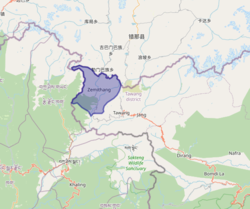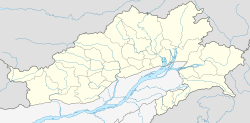Zemithang Pangchen | |
|---|---|
Village | |
 | |
 Zemithang Circle | |
| Coordinates: 27°42′38″N91°43′48″E / 27.7106891°N 91.7300530°E | |
| Country | |
| State | Arunachal Pradesh |
| District | Tawang |
| Elevation | 2,120 m (6,960 ft) |
| Population (2011) | |
• Total | 2,498 |
| Time zone | UTC+5:30 (IST) |
Zemithang (Tibetan : བྱེ་མ་ཐང།, Wylie : bye ma thang [a] ) or Pangchen (Tibetan : སྤང་ཆེན, Wylie : spang chen), is a village and the headquarters of an eponymous circle in the Tawang district of Indian state of Arunachal Pradesh. It is on the bank of the Nyamjang Chu river, which originates in Tibet and enters India from the north near the locality called Khinzemane.
Contents
The Zemithang Circle is the last administrative division of India on the border with the Tibet Autonomous Region of China, along the border with Bhutan in the west. [2] [3] [4] It has a population of 2,498 people by the 2011 census, distributed in 18 villages. The Zemithang Circle and the Dudunghar Circle to its south, together make up a community development block. [5] Zemithang's border with Tibet, along the Namka Chu and Sumdorong Chu valleys, is disputed with China. [6]
Zemithang was the first point in India that the 14th Dalai Lama arrived in India as he fled China for India in 1959 following the Chinese occupation of Tibet. [6] He settled at the Tawang Monastery; 70 km southeast, on 30 March before moving on a month later to Uttarakhand to meet then Indian Prime Minister Jawaharlal Nehru. [7] The Dalai Lama has reportedly recalled the area "emotionally" as "a place where I had enjoyed freedom for the first time." [7]








